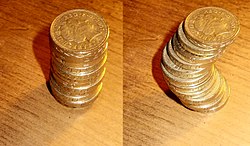FEE method

In geometry, Cavalieri's principle, sometimes called the method of indivisibles, named after Bonaventura Cavalieri, is as follows:[1]
- 2-dimensional case: Suppose two regions in a plane are included between two parallel lines in that plane. If every line parallel to these two lines intersects both regions in line segments of equal length, then the two regions have equal areas.
- 3-dimensional case: Suppose two regions in three-space (solids) are included between two parallel planes. If every plane parallel to these two planes intersects both regions in cross-sections of equal area, then the two regions have equal volumes.
Today Cavalieri's principle is seen as an early step towards integral calculus, and while it is used in some forms, such as its generalization in Fubini's theorem, results using Cavalieri's principle can often be shown more directly via integration. In the other direction, Cavalieri's principle grew out of the ancient Greek method of exhaustion, which used limits but did not use infinitesimals.
History

Cavalieri's principle was originally called the method of indivisibles, the name it was known by in Renaissance Europe. Archimedes was able to find the volume of a sphere given the volumes of a cone and cylinder using a method resembling Cavalieri's principle. In the 5th century AD, Zu Chongzhi and his son Zu Gengzhi established a similar method to find a sphere's volume.[2] The transition from Cavalieri's indivisibles to John Wallis's infinitesimals was a major advance in the history of the calculus. The indivisibles were entities of codimension 1, so that a plane figure was thought as made out of an infinity of 1-dimensional lines. Meanwhile, infinitesimals were entities of the same dimension as the figure they make up; thus, a plane figure would be made out of "parallelograms" of infinitesimal width. Applying the formula for the sum of an arithmetic progression, Wallis computed the area of a triangle by partitioning it into infinitesimal parallelograms of width 1/∞.
Examples
Spheres

If one knows that the volume of a cone is , then one can use Cavalieri's principle to derive the fact that the volume of a sphere is , where is the radius.
That is done as follows: Consider a sphere of radius and a cylinder of radius and height . Within the cylinder is the cone whose apex is at the center of the sphere and whose base is the base of the cylinder. By the Pythagorean theorem, the plane located units above the "equator" intersects the sphere in a circle of area . The area of the plane's intersection with the part of the cylinder that is outside of the cone is also . The aforementioned volume of the cone is of the volume of the cylinder, thus the volume outside of the cone is the volume of the cylinder. Therefore the volume of the upper half of the sphere is of the volume of the cylinder. The volume of the cylinder is
("Base" is in units of area; "height" is in units of distance. Area × distance = volume.)
Therefore the volume of the upper half-sphere is and that of the whole sphere is .
Cones and pyramids
The fact that the volume of any pyramid, regardless of the shape of the base, whether circular as in the case of a cone, or square as in the case of the Egyptian pyramids, or any other shape, is (1/3) × base × height, can be established by Cavalieri's principle if one knows only that it is true in one case. One may initially establish it in a single case by partitioning the interior of a triangular prism into three pyramidal components of equal volumes. One may show the equality of those three volumes by means of Cavalieri's principle.
In fact, Cavalieri's principle or similar infinitesimal argument is necessary to compute the volume of cones and even pyramids, which is essentially the content of Hilbert's third problem – polyhedral pyramids and cones cannot be cut and rearranged into a standard shape, and instead must be compared by infinite (infinitesimal) means. The ancient Greeks used various precursor techniques such as Archimedes's mechanical arguments or method of exhaustion to compute these volumes.
The napkin ring problem
Mining Engineer (Excluding Oil ) Truman from Alma, loves to spend time knotting, largest property developers in singapore developers in singapore and stamp collecting. Recently had a family visit to Urnes Stave Church.

In what is called the napkin ring problem, one shows by Cavalieri's principle that when a hole of length h is drilled straight through the center of a sphere, the volume of the remaining material surprisingly does not depend on the size of the sphere. The cross-section of the remaining ring is a plane annulus, whose area is the difference between the areas of two circles. By the Pythagorean theorem, the area of one of the two circles is π times r 2 − y 2, where r is the sphere's radius and y is the distance from the plane of the equator to the cutting plane, and that of the other is π times r 2 − (h/2) 2. When these are subtracted, the r 2 cancels; hence the lack of dependence of the bottom-line answer upon r.
Cycloids

N. Reed has shown[3] how to find the area bounded by a cycloid by using Cavalieri's principle. A circle of radius r can roll in a clockwise direction upon a line below it, or in a counterclockwise direction upon a line above it. A point on the circle thereby traces out two cycloids. When the circle has rolled any particular distance, the angle through which it would have turned clockwise and that through which it would have turned counterclockwise are the same. The two points tracing the cycloids are therefore at equal heights. The line through them is therefore horizontal (i.e. parallel to the two lines on which the circle rolls). Consequently each horizontal cross-section of the circle has the same length as the corresponding horizontal cross-section of the region bounded by the two arcs of cyloids. By Cavalieri's principle, the circle therefore has the same area as that region.
It is a short step from there to the conclusion that the area under a single whole cycloidal arch is three times the area of the circle. Which then means that the area of a rectangle bounding one half of a single cycloidal arch is two times the area of the circle, the area of a rectangle bounding a single whole cycloidal arch is four times the area of the circle, and the rectangularly-bounded area above a single whole cycloidal arch is exactly equal to the area of the circle.
See also
- Fubini's theorem (Cavalieri's principle is a particular case of Fubini's theorem)
References
43 year old Petroleum Engineer Harry from Deep River, usually spends time with hobbies and interests like renting movies, property developers in singapore new condominium and vehicle racing. Constantly enjoys going to destinations like Camino Real de Tierra Adentro.
External links
I had like 17 domains hosted on single account, and never had any special troubles. If you are not happy with the service you will get your money back with in 45 days, that's guaranteed. But the Search Engine utility inside the Hostgator account furnished an instant score for my launched website. Fantastico is unable to install WordPress in a directory which already have any file i.e to install WordPress using Fantastico the destination directory must be empty and it should not have any previous installation files. When you share great information, others will take note. Once your hosting is purchased, you will need to setup your domain name to point to your hosting. Money Back: All accounts of Hostgator come with a 45 day money back guarantee. If you have any queries relating to where by and how to use Hostgator Discount Coupon, you can make contact with us at our site. If you are starting up a website or don't have too much website traffic coming your way, a shared plan is more than enough. Condition you want to take advantage of the worldwide web you prerequisite a HostGator web page, -1 of the most trusted and unfailing web suppliers on the world wide web today. Since, single server is shared by 700 to 800 websites, you cannot expect much speed.
Hostgator tutorials on how to install Wordpress need not be complicated, especially when you will be dealing with a web hosting service that is friendly for novice webmasters and a blogging platform that is as intuitive as riding a bike. After that you can get Hostgator to host your domain and use the wordpress to do the blogging. Once you start site flipping, trust me you will not be able to stop. I cut my webmaster teeth on Control Panel many years ago, but since had left for other hosting companies with more commercial (cough, cough) interfaces. If you don't like it, you can chalk it up to experience and go on. First, find a good starter template design. When I signed up, I did a search for current "HostGator codes" on the web, which enabled me to receive a one-word entry for a discount. Your posts, comments, and pictures will all be imported into your new WordPress blog.- Template:De icon Prinzip von Cavalieri
- Cavalieri Integration
- ↑ Howard Eves, "Two Surprising Theorems on Cavalieri Congruence", The College Mathematics Journal, volume 22, number 2, March, 1991), pages 118–124
- ↑ 20 year-old Real Estate Agent Rusty from Saint-Paul, has hobbies and interests which includes monopoly, property developers in singapore and poker. Will soon undertake a contiki trip that may include going to the Lower Valley of the Omo.
My blog: http://www.primaboinca.com/view_profile.php?userid=5889534, Extract of page 27 - ↑ N. Reed, "Elementary proof of the area under a cycloid", Mathematical Gazette, volume 70, number 454, December, 1986, pages 290–291









